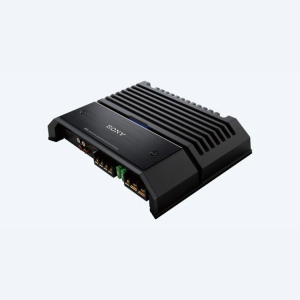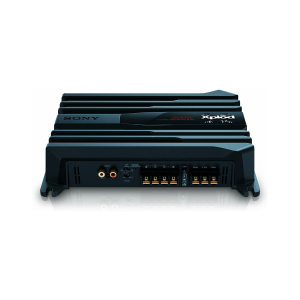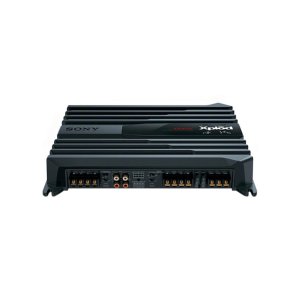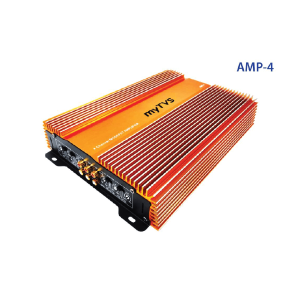Showing 1–1 of 8 results
AMPLIFIERS FOR MORE POWER AND GREATER VOLUME
The head unit in a factory car audio system contains a small built-in amplifier to power a small number of speakers. Premium aftermarket sound systems usually have a powerful, outboard amplifier to send audio signals to a large number of speakers and achieve higher sound quality.
Amplifiers are often placed under a seat or in the trunk of a car and are therefore rarely seen. However, amplifiers are an integral component to provide power and volume to the car’s audio system. And they are important to reproduce high quality music as well. Without an amplifier, music in the car just won’t sound powerful enough.
The amplifiers’ main function is to boost the audio signal from the head unit so that they are powerful enough to move the cones of the speaker and reproduce the sound. Before the signal is amplified it is put through a preamplifier component.
PREAMPLIFIERS
There can be more than one preamplifier component in the sound system. Preamplifiers process the sound before it is sent to the amplifier. The preamplifier takes the sound signal from the head unit that is sourcing music from a CD player or radio, and sends a low-level output for the amplifier to process.
In the preamplifier, the bass, treble and equalisation are manipulated and the sound is adjusted at this point. When the signal finally reaches the amplifier, the internal input of the preamplifier will process the sound further.
CROSS OVER
In the preamplifier circuit, there is a component known as cross over. Its job is to separate the full range audio into sequential frequencies that have to be fed into the amplifier. It directs separate frequencies so that they can be fed into the woofers, tweeters and subwoofers depending on their frequency range (Ultra high, medium and low).
Audio systems may use two types of crossovers, active crossover and passive crossover. An active crossover takes the signal from the head unit, which is a full range audio frequency spectrum and divides it into separate frequencies for an amplifier's separate channel that are fed to individual speakers such as subwoofers, woofers and tweeters. A passive crossover takes the signal after it has been amplified and sends it to specific speakers after syphoning off each frequency.
Passive crossovers are often found on two-way speakers, that is a pair of speakers that are mounted onto a single frame. Two-way speakers that are found in most car audio systems feature a large midrange speaker and a small tweeter. The audio signal passes through the passive crossover and two separate signals are sent to the specific speakers for sound reproduction.
WHAT’S THE DIFFERENCE BETWEEN 2 CHANNEL AND 4 CHANNEL AMPLIFIERS?
2 channel sound systems have 2 signals, one for the left side and another for the right side, thereby producing a stereo effect. 4 channel sound systems further split this signal into front and rear to produce quadraphonic sound.
4 channel amplifiers are really a 2-channel amplifier with an added stereo channel pair designed into its working. A 4-channel amplifier has the following benefits:
· It is designed to work with front and rear speakers in addition to separate channels for left and right speakers
· You can use the full range for the front speakers and use the rear channel for the subwoofer.
· It is a more compact set up as compared to 2 separate stereo amplifiers.
Most 4 channel amplifiers can be bridged which makes their set up quite flexible. A 2 channel or 4 channel amplifier will require an impedance rating of at least 4 ohms when bridged.
AN AMP MEANS BETTER SOUND IN THE CAR
Whether you need loud music or soft, an amplifier will breathe new life into your audio experience. So, what exactly does an amplifier do?
· An amplifier will boost the sound reproduction and give you a more clear and intelligible sound
· It will improve the quality of the music and reduce distortion
· Aftermarket speakers sound better when hooked up to an amplifier than they would with just the head unit built in amplifier
· A subwoofer will most likely require an amplifier because they need to propagate a powerful sound and require extra power.
An amplifier may cost anywhere from Rs.5000 to Rs.10,000 for high end units.
CAR AMPLIFIER WIRING KIT
Most people think that wiring a car amplifier is a complicated task and is best left to the professionals. But with the plethora of installation guides and videos out there, it is actually quite straightforward and easy to accomplish.
First, get the wiring diagram for how your amplifier will fit in with the car’s electrical components and the speakers. The wiring diagram will show you the positions of speakers, receivers, the amplifier, and the subwoofer, while displaying how the wires between these components should be laid out.
You will need:
· An amplifier wiring kit· Speaker cables
· Distribution locks
· RCA wires
Capacitors aren’t usually required in the wiring kit but can be added if deemed necessary.
You may also want to hook up your bass speaker to the system. The wiring diagram for the subwoofer should be obtained.
The subwoofer should have speaker level inputs. You’ll need the following items for the installation:
· Wiretaps· A fuse connector along with 2A and 10A fuse
· An amplifier wiring kit
· Speaker wires
FREQUENTLY ASKED QUESTIONS
Q1. Why do I need an amplifier in my car?
Ans. If the sound gets distorted when you turn up the volume in the car, then you need an amplifier. The difference is like the sound you get from your TV speakers and the audio experience of a home theatre system. An amplifier in your car hooked up to the audio system will make that difference. You’ll hear a fuller, louder sound of higher quality especially if you installed good quality speakers in your car.
Q2. How do I choose the best amplifier?
Ans. The first thing you must determine is how many speakers you will be attaching to the amplifier and what kind of power they can handle. Once that is done, you will narrow down how many channels you are going to need and how powerful the amplifier should be.
Q3. Can I install the amplifier myself?
Ans. As long as you have a basic understanding of electronics and are handy with tools, you can install the amplifier in your car yourself. First, you have to install a wire from the car battery to the amplifier location. Then you need to install a ground wire from the amplifier to the chassis of the car. It is essential to get the job done right without any damage to either the amplifier or the car.
Q4. How many watts of power should the amplifier have?
Ans. Find out how much power your speakers can handle in RMS watts. The subwoofer power rating should more or less match the amplifier's power rating. Speakers are fine unless you want to max them out. More power equal’s better sound.
Q5. How many channels should my amplifier have?
Ans. The rule is “one channel per speaker”. So, you will need two channels to power a pair of speakers, 4 channels to power front and rear speakers, and one extra channel to power the subwoofer. But there are plenty of exceptions to this rule, so contact a certified technician before doing anything.









